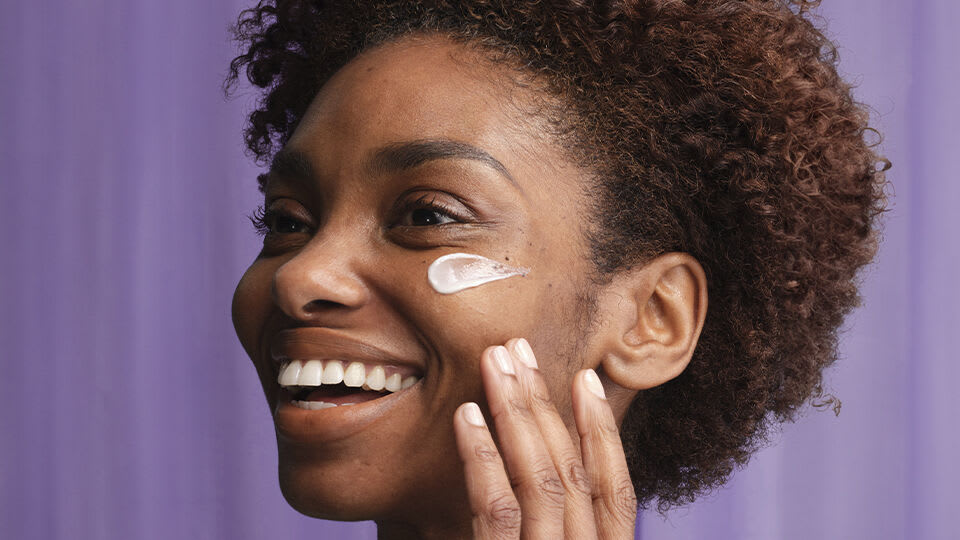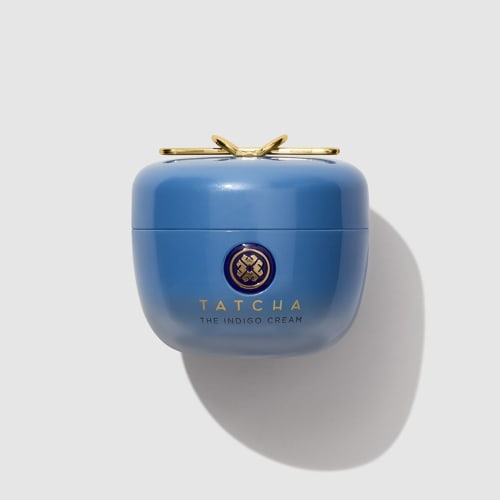When redness shows up, it can be tough to calm things down. Choosing the right moisturizer or face cream can help keep things clear—if you know what ingredients to look for.

When the blood vessels that lay beneath the skin widen or break, it can cause redness to bloom across cheeks in patches and spots. This kind of redness happens to everyone, and can be caused by anything from spicy noodles to garden variety embarrassment. And it’s perfectly human to blush: A little color looks good on all of us.
But when facial redness is chronic, it may be a sign of rosacea, an inflammatory condition that affects 14 million Americans, according to the Cleveland Clinic. The word rosacea comes from the Latin rosaceus, a turn of the century term for something rose-colored; the word resurged in the 2000s as interest in skincare bloomed (and nomenclature for its various issues proliferated). But the issue has affected people for centuries. An article in the European Journal of Dermatology identified one of the first doctors to identify the skin condition; in the 14th century, a French surgeon observed a case of "goutterose", which expressed itself in red patches “particularly on the nose and cheeks.”
Today, rosacea looks much the same as it did back then, but our understanding of it is more than skin deep. As the Mayo Clinic’s definition of rosacea explains, the exact causes aren’t known, but “could be due to an overactive immune system, heredity, environmental factors or a combination of these.” Even longer is the list of potential aggravators, which range from sun to stress to spice to skincare. Those with rosacea or persistent redness may even be wary of certain skincare products, for fear that they’ll bring out their blood vessels.
It’s true that, when caring for rosacea and redness, a certain amount of caution is well-advised. But certain skincare products and ingredients can actually help to soothe and calm skin, including the best moisturizer for rosacea.
Why is my skin so red?
Like other inflammatory skin conditions, such as eczema, experts aren’t exactly sure what causes rosacea, but various studies have revealed patterns about who is and isn’t affected. For example; women are 3 to 4 times more likely than men to develop rosacea, but men who are affected often suffer worse symptoms. Rosacea also tends to run in families.
There are a few stages of a rosacea flare-up. First, in the vascular stage, blood vessels expand and break. Skin flushes, the result may appear like a facial rash. This redness might also be accompanied by small bumps or pimples in the inflammatory stage. Men who experience rosacea may also experience rhinophyma, in which the skin on the nose thickens and oil glands enlarge, according to John Hopkins Medicine’s classification of rosacea. Rosacea can even spread to the eyes and cause itching, watering, and, of course, redness.
If any of these symptoms sound typical of your skin, it’s possible you have rosacea, or redness-prone skin. A visit to your dermatologist can help you rule out other possibilities, and will help you on your way to starting a treatment plan.
Can skincare products help redness?
Skincare products can be enormously helpful for redness and rosacea.
The American Academy of Dermatology Association has published guidelines for caring for red skin and rosacea that emphasize a gentle approach. Finding a mild cleanser, applying it using your fingertips, rinsing with cool or lukewarm water, and then drying your skin with a soft, clean cloth is the best way to wash rosacea or redness-prone skin. You can skip the astringent toners or abrasive towels.
Another way to be gentle to your skin is by moisturizing regularly. The term “moisturizer” describes a wide category of products that work by helping skin retain water, which is necessary for skin’s health. Even a skincare routine consisting of just a mild cleanser, a hydrating moisturizer, and a sunscreen is enough to give your skin what it needs—and protect it from what it doesn’t.
But like many other factors, some skincare formulations could cause reactions. What works for you depends on your unique skin type. Stick to products and ingredients that are tried-and-true—and if you decide to try something new, don’t forget to patch test it first.
Which skincare ingredients help rosacea and redness?
As rosacea has emerged as a breakout skincare topic in the past few decades, many new skincare technologies have been developed with the aim of soothing and calming skin—from lasers to topical applications. And yet, much like rosacea itself, many of the ingredients used to help reduce redness have long histories.
Ceramides. Of course ceramides are good for skin—up to 50% of our epidermis is made up of these fat cells. There, they help our skin retain water and perform its barrier function, keeping good stuff in and bad stuff out. Added into skincare formulations, they have been shown to help soothe visible irritation and prevent dehydration.
Colloidal oatmeal. The calming oatmeal variant has been used for centuries to relieve itch and irritation—the Egyptians used to pour oats into their baths to relieve inflamed skin. Today, many formulas with colloidal oatmeal are recommended for issues like eczema and rosacea.
Green tea. The extract from green tea is rich in polyphenols, which are known to have strong antioxidant and anti-inflammatory properties.
Japanese indigo extract. A supremely soothing superplant. Indigo has a more famous reputation for the beautiful dye it produces, but its medicinal benefits are well-recorded throughout history. In Japan, indigo was also used for traditional firefighter uniforms to protect against burns, and presented to newborns in the form of an indigo-dyed blanket—a testament to its protective qualities. (Did you know that indigo is green at first, until it reacts with oxygen to give it its distinctive deep blue?)
Sea fennel extract. Long renowned for its culinary applications, sea fennel also works wonders on skin. The marine botanical impressively toes the line between zero inflammation and big, retinol-like results, making it a great choice ingredient for those with redness or rosacea.
Silk. There is simply no fabric that is softer on skin than silk. Liquid silk proteins find their way into many formulas for their skin nourishing benefits, but pure silk fabric is also a source of particular inspiration for Tatcha, as seen in our Kinu Pure Silk Polishing Face Cloth. If you’re looking for an easy way to make your routine more gentle, consider switching to silk wash cloths and pillowcases.
What is the best moisturizer for rosacea and redness?
Hydration is essential for our skin’s health: Water is the one of the most important fuels that keeps our skin barrier in proper form. And the best way to hydrate your skin is by using a moisturizer.
Most skincare users tend to match their moisturizer to their skin type. Oily skin types sometimes go for powerful gel formulas that help clear away excess sebum, whereas dry skin types might slather on a thick cream that gives them an extra boost of hydration. For those dealing with rosacea or redness, the goal is to keep things calm and under control; the easiest way to that goal is to choose a moisturizer fortified with ingredients proven to help redness.
One such moisturizer is Tatcha’s Indigo Overnight Repair, which features skin-soothing Japanese indigo along with ceramides. The unique product composition also helps to regulate the skin’s microbiome (studies show a link between a disrupted microbiome and inflammation) and visibly calms skin irritation—after just one night, about 90% of participants saw improvements in skin redness, texture, and tone.* The serum-in-cream is also the finale in Tatcha’s best-selling Soothing and Calming Skin Ritual, a full four-step redness routine in one kit.
What about my eczema?
Redness happens to be a common symptom of inflammatory eczema. Eczema’s other signs vary to include dryness, itchiness, bumps, and even changes in texture. Luckily, many ingredients that soothe redness and rosacea are also known to help with eczema.
The National Eczema Association makes finding these moisturizers a little easier by assigning seals of approval to formulas that meet calming criteria. That seal can be found on Tatcha’s Indigo Calming Cream, formulated with indigo and colloidal oatmeal. It soothes redness with long-lasting hydration, but it also works overtime, as both a daily moisturizer and a soothing skin treatment. Apply it to the face, neck, or anywhere irritated skin appears.
Rosacea and redness can also be a source of stress, which happens to be a common trigger for rosacea and redness. It can seem like a never-ending cycle. But a consistent skincare routine can help, and provides a daily opportunity to reflect on your progress and skin’s goals. The process will definitely soothe your skin; it may soothe your mind, too.
*Based on a 4-week clinical study of 41 participants.






